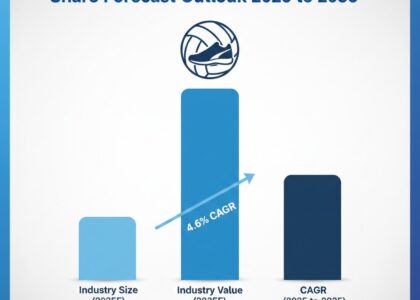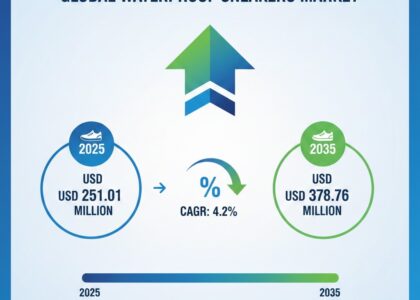𝐈𝐧𝐭𝐫𝐨𝐝𝐮𝐜𝐭𝐢𝐨𝐧: 𝐁𝐞𝐲𝐨𝐧𝐝 𝐀𝐞𝐬𝐭𝐡𝐞𝐭𝐢𝐜𝐬 𝐢𝐧 𝐃𝐞𝐜𝐨𝐫𝐚𝐭𝐢𝐯𝐞 𝐏𝐚𝐢𝐧𝐭𝐬
The decorative paints market has long been synonymous with color palettes, interior aesthetics, and design trends. For years, consumer demand and brand competition largely revolved around visual appeal and cost-effectiveness. However, a quiet but potent transformation is underway—one that moves the focus from visual allure to environmental adaptability. In a world grappling with extreme weather events, rising humidity in coastal zones, and soaring temperatures in urban heat islands, decorative paints are evolving into a functional line of defense tailored to regional climate challenges. Market leaders are beginning to leverage microclimate-specific formulations not just as technical innovations, but as strategic tools to stand out in an increasingly crowded market.
𝐌𝐚𝐤𝐞 𝐈𝐧𝐟𝐨𝐫𝐦𝐞𝐝 𝐃𝐞𝐜𝐢𝐬𝐢𝐨𝐧𝐬 – 𝐀𝐜𝐜𝐞𝐬𝐬 𝐘𝐨𝐮𝐫 𝐒𝐚𝐦𝐩𝐥𝐞 𝐑𝐞𝐩𝐨𝐫𝐭 𝐈𝐧𝐬𝐭𝐚𝐧𝐭𝐥𝐲! https://www.futuremarketinsights.com/reports/sample/rep-gb-439
𝐂𝐥𝐢𝐦𝐚𝐭𝐞–𝐒𝐩𝐞𝐜𝐢𝐟𝐢𝐜 𝐅𝐨𝐫𝐦𝐮𝐥𝐚𝐭𝐢𝐨𝐧𝐬: 𝐀 𝐒𝐭𝐫𝐚𝐭𝐞𝐠𝐢𝐜 𝐈𝐧𝐧𝐨𝐯𝐚𝐭𝐢𝐨𝐧 𝐕𝐞𝐜𝐭𝐨𝐫
Formulating decorative paints that adapt to localized weather conditions represents a strategic shift in product innovation. No longer limited to generic emulsion or oil-based varieties, the new generation of decorative paints incorporates climate-resilient features. Heat-reflective paints for high-sun exposure regions, antimicrobial nanocoating for humid climates, and alkali-resistant primers for saline-heavy coastal areas are just a few examples. These niche products are not only solving practical problems but also driving market segmentation in ways previously unexplored.
R&D spending in this domain is rising, with companies like AkzoNobel and Asian Paints investing in climate labs to test how their formulations behave under different environmental stressors. This move from generalized paints to tailored solutions allows companies to position themselves as solution providers rather than mere suppliers. It adds a layer of brand differentiation that resonates with both retail consumers and institutional buyers such as real estate developers and public infrastructure planners.
𝐂𝐚𝐬𝐞 𝐄𝐱𝐚𝐦𝐩𝐥𝐞𝐬: 𝐑𝐞𝐠𝐢𝐨𝐧𝐚𝐥 𝐂𝐮𝐬𝐭𝐨𝐦𝐢𝐳𝐚𝐭𝐢𝐨𝐧 𝐢𝐧 𝐀𝐜𝐭𝐢𝐨𝐧
The microclimate-driven innovation trend is most evident in regions where environmental conditions pose persistent challenges. In tropical Southeast Asia, where high humidity leads to rapid fungal growth and paint degradation, companies have introduced anti-algae, moisture-resistant paints specifically designed for the monsoon season. Nippon Paint, for instance, has developed products with mold-resistant polymers tailored to withstand prolonged dampness in regions like Indonesia and the Philippines.
In the Middle East, particularly in the Gulf Cooperation Council (GCC) countries, decorative coatings are engineered to reflect solar radiation and resist fading due to intense UV exposure. Here, manufacturers emphasize solar reflectance index (SRI) ratings to appeal to sustainability-focused real estate projects seeking to improve thermal insulation.
Conversely, in Northern Europe where temperature swings and frost cycles dominate, flexibility and crack resistance become key. Paints formulated for Scandinavian homes often include elastomeric binders that allow surfaces to expand and contract without fracturing the coating, a vital quality in regions with frequent freeze-thaw cycles.
These regional adaptations are helping companies penetrate markets more effectively, reducing product returns and boosting consumer satisfaction—an outcome that is hard to achieve through traditional, one-size-fits-all decorative paints.
𝐔𝐧𝐥𝐨𝐜𝐤 𝐂𝐨𝐦𝐩𝐫𝐞𝐡𝐞𝐧𝐬𝐢𝐯𝐞 𝐌𝐚𝐫𝐤𝐞𝐭 𝐈𝐧𝐬𝐢𝐠𝐡𝐭𝐬 – 𝐄𝐱𝐩𝐥𝐨𝐫𝐞 𝐭𝐡𝐞 𝐅𝐮𝐥𝐥 𝐑𝐞𝐩𝐨𝐫𝐭 𝐍𝐨𝐰: https://www.futuremarketinsights.com/reports/decorative-paints-market

𝐂𝐨𝐧𝐬𝐮𝐦𝐞𝐫 𝐁𝐞𝐡𝐚𝐯𝐢𝐨𝐫 𝐚𝐧𝐝 𝐭𝐡𝐞 𝐑𝐢𝐬𝐞 𝐨𝐟 𝐂𝐥𝐢𝐦𝐚𝐭𝐞–𝐂𝐨𝐧𝐬𝐜𝐢𝐨𝐮𝐬 𝐏𝐫𝐞𝐟𝐞𝐫𝐞𝐧𝐜𝐞𝐬
Today’s consumers are better informed, more environmentally aware, and increasingly influenced by localized product performance. According to recent consumer surveys in the decorative paints segment, a significant portion of urban homeowners are willing to pay a premium for paints that offer protection against humidity, heat, or microbial growth, especially if those features translate into long-term savings and less maintenance.
Social media and product review platforms have further amplified this shift, with buyers actively discussing product longevity in specific weather conditions. For example, a paint that maintains vibrancy through three harsh Indian summers is more likely to receive organic promotion than one that peels within a year. This has forced brands to not only innovate but also to back up their claims with region-specific performance data, often visible in the form of third-party certifications or warranties tailored by climate zone.
𝐈𝐦𝐩𝐚𝐜𝐭 𝐨𝐧 𝐌𝐚𝐫𝐤𝐞𝐭 𝐒𝐡𝐚𝐫𝐞 𝐚𝐧𝐝 𝐂𝐨𝐦𝐩𝐞𝐭𝐢𝐭𝐢𝐯𝐞 𝐒𝐭𝐫𝐚𝐭𝐞𝐠𝐲
The ability to tailor paint solutions to specific climates is increasingly becoming a key differentiator in competitive strategy. Emerging players and niche brands are using climate adaptation as an entry point into markets historically dominated by legacy paint manufacturers. By focusing on microclimate customization, these firms are carving out substantial market share in regions where generic products fall short.
A compelling example comes from a mid-sized decorative paint brand in Brazil that specialized in mildew-resistant paints for the Amazon basin. Their hyper-local approach helped them grow faster than some of the larger competitors who offered only standard emulsions. The strategy of coupling localized product performance with sustainable packaging and low-VOC (volatile organic compound) formulations allowed them to gain traction among both residential customers and green building developers.
Additionally, this trend is influencing procurement strategies in the institutional and construction segments. Architects, builders, and contractors are now prioritizing performance certifications tied to local climate conditions, giving a distinct edge to brands with a proven climate-specific portfolio. This downstream influence is helping brands not only capture retail segments but also build B2B relationships that drive long-term revenue.
𝐓𝐡𝐞 𝐍𝐞𝐱𝐭 𝐅𝐫𝐨𝐧𝐭𝐢𝐞𝐫 𝐢𝐧 𝐃𝐞𝐜𝐨𝐫𝐚𝐭𝐢𝐯𝐞 𝐏𝐚𝐢𝐧𝐭𝐬
The decorative paints market is undergoing a profound transformation—one that stretches far beyond color trends and aesthetic choices. Microclimate-specific paint formulations are redefining how brands approach product development, marketing, and distribution. These innovations are reshaping the industry’s value chain and offering a new lens through which market share and consumer loyalty are won.
As urbanization intensifies and climate variability becomes the norm, paints that are engineered for performance under specific environmental conditions will increasingly dictate brand success. Companies that integrate R&D with local climate data and consumer feedback are poised to lead this shift, turning what was once a commodity product into a high-performance, solution-driven offering. For investors, market analysts, and industry stakeholders, tracking the evolution of microclimate adaptation in decorative paints may reveal tomorrow’s market leaders ahead of the curve.
𝐂𝐨𝐚𝐭𝐢𝐧𝐠𝐬, 𝐈𝐧𝐤𝐬, 𝐀𝐝𝐡𝐞𝐬𝐢𝐯𝐞𝐬 & 𝐒𝐞𝐚𝐥𝐚𝐧𝐭𝐬 𝐈𝐧𝐝𝐮𝐬𝐭𝐫𝐲 𝐀𝐧𝐚𝐥𝐲𝐬𝐢𝐬: https://www.futuremarketinsights.com/industry-analysis/coatings-inks-adhesives-and-sealants






